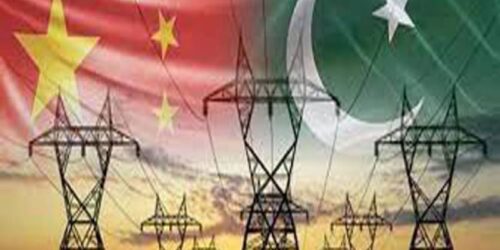Ups and downs are considered a routine matter in bilateral diplomatic ties among the world nations, but it does not apply to Pakistan and China as their multi-dimensional relations always witnessed a unique strength with each passing day for the last 70 years in all weathers.
The two countries are enjoying unprecedented and deep-rooted friendship and cooperation in almost all spheres of life; and the energy sector is one of them under which Pakistan is steadily inching towards attaining self-sufficiency through a number of power generation projects initiated in collaboration with China especially under China Pakistan Economic Corridor (CPEC) Project.
The latest project that has been completed with the Chinese assistance is Karachi Nuclear Power Plant Unit-2 (K-2) having 1100 MW capacity which will be formally inaugurated on Friday (May 21).
K-2 is a generation III, state of the art plant with improved safety systems, especially internal and external accident prevention ability and enhanced emergency response capability.
The construction of K-2 commenced in November 2013, whereas its fuel loading started on December 01, 2020, after approval from the Pakistan Nuclear Regulatory Authority (PNRA). After further reactor physics tests, plant was connected to national grid on March 18, 2021 for trial operation and power escalation tests.
Meanwhile, Karachi Nuclear Power Plant Unit-3 (K-3), with similar capacity is also in commissioning phase and is expected to start production during first quarter of 2022.
Official sources told APP that huge over $ 46 billion foreign investment under China-Pakistan Economic Corridor (CPEC) poured into the country. Out of total, some $ 34 billion was invested in the power projects.
The official said nine out of 22 energy projects had been completed, while five mega electricity projects in Thar, Kohala, Azad Pattan and others were in the pipeline.
After completion of all the projects, Pakistan would not only become self-sufficient in the energy with addition of 17,045 MW electricity to the national grid but would also able to export it.
Some other power projects that had already been commissioned included 1320 MW Sahiwal Coal Power Plany, 1000 MW Quaid e Azam Solar Park, 1320 MW Rahimyar Khan Coal Power Plant, LNG based plants in Bhikki, CHASHNUPP-IV, LNG based Plants in Balloki, 1320 MW Port Qasim Power Project Unit-I-II, Patrind Hydropower etc.
Similarly, Suki Kinari Hydro Power, Karot Hydro Power Projects were also being set up with Chinese assistance under CPEC. About 60 percent work of the Suki Kinari Hydro Power Project had been completed would become operational in December 2022, official in CPEC authority told.
The 884 MW Suki Kinari hydro power project was being set up at River Kunhar, Kaghan with an estimated cost of $2 billion.
According to a CPEC Authority official, the mega project would move forward with more strength during the current year and the years ahead, which would further strengthen the bilateral relations between Pakistan and China.
Their strategic relationship, which was being strengthened with every passing day, was of great importance both on regional as well as international fronts.
Suki Kinari is a run-of-the-river largest private sector hydropower project located on Kunhar River in the Kaghan Valley of District Mansehra, Khyber Pakhtunkhwa. The project poses minimal environmental and social impact because it is a run-of-the-river project.
It is considered one of the most cost-effective hydropower schemes in the region due to its high design head of 900 meters and relatively short intake structure crest.
This project is being supported and closely monitored by the governments of Pakistan and China due to its importance. Chinese company ‘China Gezgouba Group Corporation’ initiated the work on Suki Kinari Hydropower Project in 2017.
The project is being built on a “Build-Own-Operate and Transfer” basis in accordance with the Government of Pakistan’s Policy for Power Generation Projects 2002.
The total operational life of the project is 100 years and the company will hand over the Suki Kinari hydropower project to the Government of Pakistan after 30 years.
During this period, the company will be responsible for its maintenance and other expenditures.
The project has provided around 5,000 local jobs and it will beautify the landscape, thus attracting more tourists to come and generate greater revenue.
Similarly, 720 MW Karot Hydropower Project worth US$1,780 million was also being constructed which would be completed in April 2022.
The official said that up to 88 percent of the work has already been completed.
Like Suki Kinari, this project was also being developed on a Build-Own-Operate and Transfer (BOOT) basis at an estimated cost of $1.98 billion.
The project was being constructed on a concrete gravity of 91 meters high dam with a crest length of 320 meters near the village of Gohra. The dam’s reservoir would be approximately 152m cubic metres in volume, with a length of 27 kilometres.
Like on generation side, China was also assisting Pakistan in transmission and evacuation of electricity mostly from newly set up power plants and the ±660 kV Matiari – Lahore Transmission Line Project is first ever HVDC Transmission Line Project in Pakistan which is being executed under the framework of China-Pakistan Economic Corridor (CPEC).
This Transmission Line is spread over a span of 886 km and capable of transmitting 4000 MW power at ±660 kV. This project is being executed on BOOT basis and will be transferred to NTDC after a term of 25 years. The Project entails foreign investment to the tune of $ 1.658 billion.
The Economic Coordination Committee (ECC) has also granted approval and under the new Transmission Services Agreement (TSA), the Required Commercial Operation Date (RCOD) of transmission line has been extended from 1st March 2021 to 1st September 2021.
Meanwhile, Federal Minister for Energy (Power Division) said that the present government was actively pursuing the completion of energy projects.
He further said Lahore-Matiari was one of the mega projects that would eventually evacuate electricity from South of the country to the North improving the economic merit dispatch order of the electricity.





